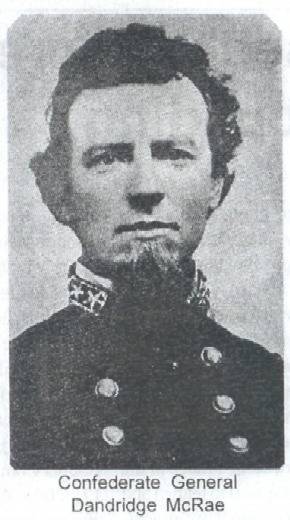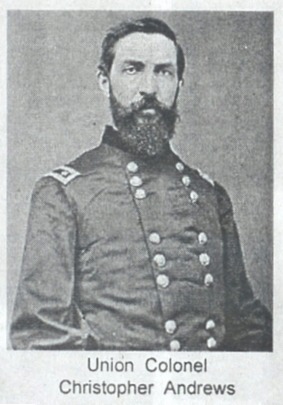The Battle of Fitzhugh's Woods,
Woodruff County, Arkansas
by Gary Telford
Part 1:
Rufus King Fitzhugh was born May 29, 1816 in King George County, Virginia. He married 21 year-old Hettie Ellen Baytop, born February 5, 1829 of Gloucester Co., Virginia, on August 13, 1850, in Gloucester Co., Virginia.
In 1860, just prior to the outbreak of the Civil War, Rufus King Fitzhugh migrated to Arkansas. He had been raising his family in the mountains of Virginia, at "Spring Hill" Greene County, but had decided that the land there was "all used up" from successive generations of farming. So he turned westward and came to Arkansas in search of a new home. He and his family traveled by horse and buggy from their home to Gordonsville, Virginia, then by train to Memphis, Tennessee, and by steamboat down the Mississippi River and up the White River to Woodruff County, Arkansas. There he purchased 800 acres of land at the community near Augusta now known as Fitzhugh. He then returned to Virginia to settle some business affairs there, and the family did not return to Arkansas until after the Civil War. Rufus did, however, send some of his slaves back to begin clearing the land and take care of things until his return.
Rufus and Hettie had eleven children born to them. Rufus died March 28, 1888 and Hettie died March 19, 1902, both in Augusta, Woodruff Co., Arkansas. Both were buried in the Augusta Memorial Park Cemetery.
The date was April 1, 1864. The place was six miles from Augusta just north of Cypress Brake where a dirt road skirted a corn field and ran through heavy timber knowns as Fitzhugh's woods. Marching north from Augusta with scouts riding ahead, a well trained regiment of men in blue, the Third Minnesota Infantry with cavalry support, was looking for a fire fight with elements of General Dandridge McRae's Army.

There are two versions of the battle that took place when these forces clashed, first with a cavalry charge across an open field, and later in the woods and in a partially cleared field known as a "deadening" where fallen logs served as some protection from snipers and sharpshooters.
The only Confederate version we have found is in a volume entitled Biographical & Historical Memoirs of Eastern Arkansas. The account is very short, only two paragraphs. It begins by stating, "Upon the approach of the Civil War in 1861 many of the citizens of the territory now embraced in Woodruff County were opposed to secession, but when actual warlike operations began they cast their lot with the Southern Confederacy." In a short time, however, five companies of militia were raised in Woodruff County largely from volunteers. Captain Charles Matlock organized the first company, Capt. James Patterson the second, Capt. Robert Anthony the third, Capt. Ed T. Jones the fourth, and finally Capt. John Bland gathered together part of a company made up mostly of deserters who had had a change of heart, and conscripts. It was the last company, Captain Bland's, that fought in the Battle of Fitzhugh's Woods. The other four units were engaged elsewhere across the South in a war with the Yankees. And it was Bland's company of raw recruits and under-trained conscripts who suffered the greatest casualties when the three hour battle was over and each side gathered up their dead and wounded.
Memoirs of Eastern Arkansas reports the battle in these few words: "In the spring of 1864 General Davidson (he was over-all commander in Little Rock) came up White River in a boat or boats with the Third Minnesota Infantry, landed at Augusta, and sent a company of about ninety men to reconnoiter. On or near the Fitzhugh farm about six miles northeast of Augusta this company encountered several hundred Confederate soldiers under the command of General Dandridge McRae. A fight ensued and the Federals fell back in good order to Augusta, suffering a small loss in killed and wounded."
By contrast the Union version of the Battle of Fitzhugh's Woods is pages long with detailed descriptions of the fight recorded by Colonel Christopher Andrews, who commanded the expedition, and more pages by Major E. W. Foster who led six small companies of Federal troops. It is officially recorded in a set of books entitled "War of the Rebellions, Official Records of the Union and Confederate Armies". These volumes are now in the library of the Tom Stanley family of Augusta.
This Yankee account of the battle begins by stating that six companies, B,C,E,G, H, and I, of the Third Minnesota Infantry totaling only 186 men, took the train from Little Rock to DeValls Bluff where they were joined by 45 more soldiers. Waiting at the DeValls Bluff Landing was the river boat Dove with a full head of steam. Col. Andrews' regiment departed immediately. The Dove was preceded up the river by the gunboat Covington as added protection.
Whenever the crew of the Covington spotted persons lurking along the river bank they stopped and picked them up for questioning. Some were detained aboard if the captain thought they might endanger the secrecy of his mission. One man turned out to be a guide later on for the Yankee troops.
When the two boats reached Gregory's Landing they tied up for there had been a report that elements of Gen. McRae's army had a camp on Straight Lake which was four miles distant. Col. Andrews dispatched a company of infantry to investigate. They marched at night through rain and darkness hoping to surprise and capture McRae's camp, but when they arrived the camp had been abandoned in the daylight hours before their arrival.
The troops rejoined their boats and proceeded to Augusta which was about 100 miles upstream from DeValls Bluff. They tied up at the Augusta Landing at 5 a.m. on April 1, and Col. Andrews' first act was to send out pickets to surround the town. Then he brought some of the Augusta citizens, and some of the colored people of the area, on board to question them about the location of McRae's forces. He learned that the principal camp of the Confederates was located seven or eight miles north of Augusta along the road that led to Jacksonport.
Part 2:
After Col. Andrews had learned that the principal camp of the Confederates was located seven or eight miles north of Augusta along the road that led to Jacksonport, the Federal troops set out immediately in that direction, with a cavalry unit in front and the infantry companies marching behind. They had gone only two miles when they encountered the first of several small bands of Confederate soldiers. The cavalry gave chase and captured two prisoners.

When the advance cavalry guard arrived at a fork in the road a few miles farther along they decided it would be best to wait for the infantry to catch up. It was here that they first caught sight of Rutherford's fighters, one of the few well trained units in McRae's Army. There was no fight at this time for Rutherford's men disappeared into the woods.
At Cypress Brake further along the road the Yankee Cavalry came upon a small group of Confederates, fired at them, and gave chase. Later they discovered that Gen. McRae was in that party on a reconnoiter mission, but he and his men escaped.
Col. Andrews and his regiment marched 12 miles up the Jacksonport road, discovered another abandoned camp, but no more Confederate soldiers, so they decided to return to their base at Augusta.
They were resting at the Fitzhugh farm on the edge of a forest when a band of Confederate horsemen appeared. This time Col. Andrews feared an ambush and ordered his cavalry not to give chase.
While they were still resting they looked up and saw a Confederate cavalry unit charging toward them across an open field. Col. Andrews quickly deployed his men as skirmishers telling them to take cover behind trees, logs, and fence rows. The Confedereate cavalry bore down on them shrieking their Rebel yell and galloping at full speed. That was when the fight really began. In the words of Major E.W. Foster, who was field commander of the Union soldiers, this is what happened: "We discovered this large force of mounted men charging at us from the right and from the rear. They came at us with loud yells across an open field. I let them approach within 150 yards, then gave the order to fire. That volley of minie-balls caused them to cease their yelling and break for the protection of the trees. I followed for a short distance and discovered there in the open field that we had inflicted a severe loss on them."
After the initial charge the battle continued for another two and a half hours. In the heat of the cross fire Col. Andrews had his horse shot from under him. Men were crouching behind fallen logs lying in ditches, or firing from behind trees. Then there was a second Confedereate charge. Major Foster describes it this way: "The enemy was again heard shooting and shouting and coming down through an open corn field on the same flank as before. I immediately fixed bayonets and charged on the double-quick to meet them, coming up in a line about 200 yards from their onrushing force which was I should judge, about 300 strong. We gave them a volley before they opened up and they broke to the rear seeking the thick timber."
Col. Andrews forces now, headed for Augusta, faced the problem of fording Cyrpess Brake with men and horses splashing through 125 yards of shallow water. This Col. Andrews considered very dangerous territory. He sent a party of sharpshooters into the woods on each side of the road that his men were to use in crossing the Brake. It was these expert marksmen stationed behind the huge cypress trees that prevented still another Confederate onslaught.
The Battle of Fitzhugh's Woods was a bloody engagement. The veteran Third Minnesota Infantry had encountered a force of Confederate troops made up largely of raw recruits who were full of Rebel yells, wild enthusiasm, but little military training. Only Rutherford's company were fully trained fighters. Col. Andrews wrote this about them: "We were aware that we were fighting experienced and daring men, especially Rutherford's men who were well known as cool fighters and good marksmen. They fought us dismounted."
Once they had passed through the Cypress Brake most of the danger to the Federal forces was over. The several companies re-formed their ranks and marched into Augusta with colors flying and the men singing "Down with the Traitors". When the regiment arrived at the Augusta Landing they halted and gave three cheers for the Stars and Stripes.
Then the soldiers in blue clambered aboard the boats, the lines were cast loose, the paddle wheels began to churn, and the Third Minnesota Infantry began its voyage down river.
The casualty report according to Col. Andrews account was 8 Union soldiers killed, 5 missing in action, and 16 wounded. There was no accurate account of Confederate casualties but Col. Andrews said, "It exceeds 100, and there were 13 prisoners taken." It has been said that the Battle Of Fitzhugh's Woods was "A Hard Little Fight."
Captain John Bland, who led his company of deserters and conscripts into that first charge at Fitzhugh's Woods, was one of the first to be killed in that hail of minie-balls. He was born December 21, 1835 and was killed April 1, 1864. He is buried in the Augusta Memorial Park Cemetery, Augusta, Woodruff Co., AR. General Dandridge McRae, a native of White County, Arkansas, was born October 10, 1829 and died April 23, 1899. His wife was Angie Lewis born October 19, 1835 and died September 26, 1919. They are both buried in the Oak Grove Cemetery in Searcy, White Co., Arkansas.

